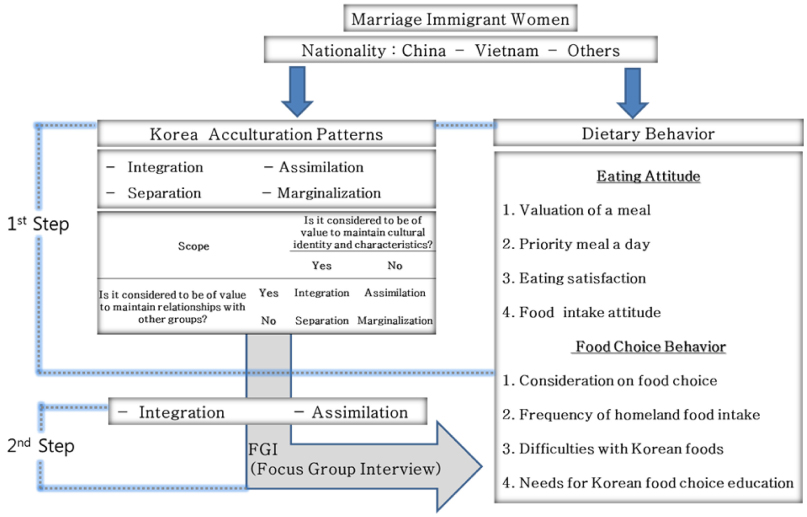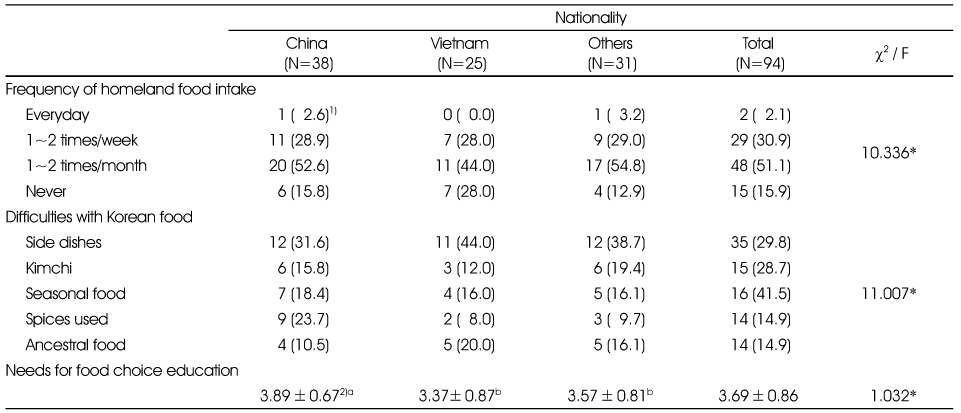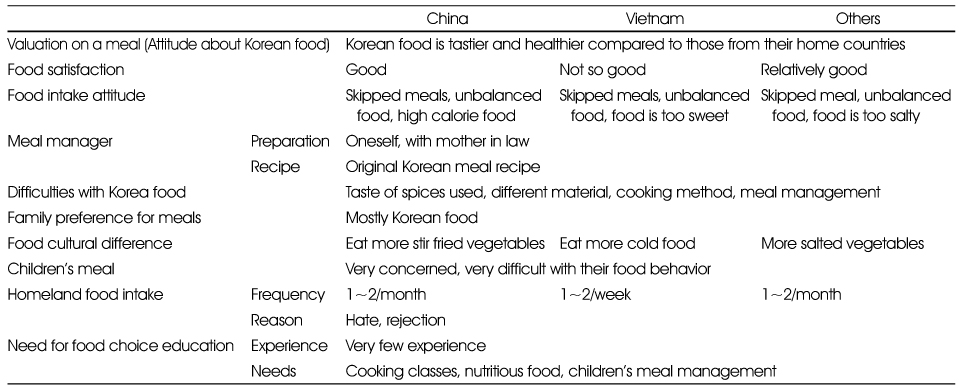Articles
- Page Path
- HOME > Korean J Community Nutr > Volume 21(1); 2016 > Article
-
Research Article
- Dietary Behavior of Marriage Migrant Women according to Their Nationality in Multicultural Families
-
Jung-Hyun Kim, Myung-Hee Lee

-
Korean Journal of Community Nutrition 2016;21(1):53-64.
DOI: https://doi.org/10.5720/kjcn.2016.21.1.53
Published online: February 29, 2016
Department of Home Economics Education, PaiChai University, Daejeon, Korea.
- Corresponding author: Myung-Hee Lee. Department of Home economics Education, Paichai University, 155-40, Baejae-ro, Seo-gu, Daejeon, 35345, Korea. Tel: (042) 520-5423, Fax: 070-4362-6292, mhlee@pcu.ac.kr
Copyright © 2016 The Korean Society of Community Nutrition
This is an Open-Access article distributed under the terms of the Creative Commons Attribution Non-Commercial License (http://creativecommons.org/licenses/by-nc/3.0/) which permits unrestricted non-commercial use, distribution, and reproduction in any medium, provided the original work is properly cited.
- 172 Views
- 1 Download
- 10 Crossref
Abstract
-
Objectives
- Nowadays, the multicultural families make up significant portion of Korean population and communities. Successful re-settling in a new country can be difficult, particularly when there are disparities in dietary behavior compared to home country. The objective of the study was to investigate the dietary behavior of marriage migrant women according to their nationality in multicultural families.
-
Methods
- The primary research was conducted targeting 94 marriage migrant women who came from China (40.4%), Vietnam (26.6%), and other countries except for Japan (33.0%). We investigated their dietary behavior, such as eating attitude and food choice behavior for Korea acculturation. We also studied dietary behavior among 14 selected subjects who had high level of integration and assimilation acculturation patterns by administering the Focus Group Interview (FGI).
-
Results
- The multicultural families had more integration acculturation patterns, which could have been influenced by their nationality. Vietnamese origin has the highest cultural adaptation as marginalization pattern. The common types of Korea acculturation were integration (3.03 ± 1.08), separation (3.10 ± 0.59), marginalization (3.10 ± 0.58), followed by assimilation (2.84 ± 0.51). There were significant differences in the four types of acculturation by marriage immigrant women's country of origin (p<0.05). According to dietary behavior, 'eliminating hunger' was the most important value in a meal. Chinese marriage migrant women, who had higher level of food intake attitude significantly, also considered 'being healthy' an important value. Regarding food choice behavior, Vietnamese had lowest frequency of homeland food intake. Most of marriage immigrant women were satisfied with the Korean food, and need for education was very high with interest for cooking, good nutrition, and managing their children's dietary life.
-
Conclusions
- Coping with a change in dietary behavior is one of the biggest transitional difficulties, and family members may need support to find their familiar food items and to continue their cultural food choice behavior in the local areas. Further researches with quantitative and qualitative analysis are needed to understand the effect of dietary behavior for acculturation in multicultural families.
Acknowledgments
Acknowledgments
- 1. Yoo YE. Case studies on the cultural adaptation of immigrant spouses and plans for support [master's thesis]. Myungji University; 2006.
- 2. Lee YB, Lee YK. A study on marital satisfaction of women marriage immigrant by self-differentiation. Korean J Fam Soc Work 2009; 26: 63-86.
- 3. Lee AL. The case study on understanding and adjustment about the family living culture in marriage emigration females -focused on mothers in a day-care center in Seoul-. J Korean Fam Resour Manage Assoc 2010; 14(4): 299-321.
- 4. Kim HS, Jung YM. Factors influencing life satisfaction of married immigrant women. J Korean Data Anal Soc 2011; 13(5): 2417-2432.
- 5. Kim YJ. Cultural conflicts and adaptation strategies of Korean migrant women in international marriage about food. J Rural Soc 2009; 19(1): 121-160.
- 6. Jung SO, Yang SJ. Types of dietary acculturation according to socio-demographic and dietary factors among female marriage immigrants in Korea. J Korean Data Anal Soc 2015; 17(5B): 2675-2689.
- 7. Lee JS. The factors for Korean dietary life adaptation of female immigrants in multi-cultural families in Busan. J Korean Soc Food Sci Nutr 2012; 41(6): 807-815.Article
- 8. Kim JM, Lee NH. Analysis of the dietary life of immigrant women from multicultural families in the Daegu area. J Korean Diet Assoc 2009; 15(4): 405-418.
- 9. Park SR. A study on the media use, cultural identity and acculturation of second generation Korean-Americans. Korean J Journal Commun Stud 2008; 52(6): 237-257.
- 10. Bae YK. A study on the Korean dietary acculturation for the Asian immigrants in Korea -focus on the country of origin and food neophobia [dissertation]. Ewha Womans University; 2011.
- 11. Kim JH. A Study on the dietary patterns affecting acculturation among marriage migrant women in urban area. J Korean Home Econ Educ Assoc 2015; 27(4): 173-189.Article
- 12. Choi HJ. Study on the characteristics pertaining to the acculturation strategies among immigrated women in Korea. Korean J Soc Welf 2009; 61(1): 163-194.Article
- 13. Lyu ES, Ryu K. Study of the Yanbian Korean housewive's knowledge of Korean traditional holidays foods. Korean J Diet Cult 1996; 11(3): 327-337.
- 14. So J, Han SN. Diet-related behaviors, perception and food preferences of multicultural families with Vietnamese wives. Korean J Community Nutr 2012; 17(5): 589-602.Article
- 15. Jung SO. Dietary acculturation and its related factors among female marriage immigrants in Korea [master's thesis]. Ewha Womans University; 2015.
- 16. Jung ML, Rho SN, Kim CS. The survey of anthropometric data and dietary behavior of Chinese middle and high school students living in Incheon, Korea. J East Asian Soc Diet Life 2007; 17(3): 289-303.
- 17. Berry JW. Four modes of acculturation. Arch Med Res 1990; 9: 142-150.
- 18. Danuri. Multicultural family statistics [internet]. 2015; cited 2015 Jun 20]. Available from: http://www.liveinkorea.kr/.
- 19. Barry DT. Development of a new scale for measuring acculturation: the East Asian Acculturation Measure (EAAM). J Immigr Health 2001; 3(4): 193-197.
- 20. Landrine H, Klonoff EA. The African American acculturation scale. J Black Psychol 1994; 20(2): 104-127.
- 21. Berry JW. Acculturation: Living successfully in two cultures. Int J Intercult relat 2005; 29(6): 697-712.
- 22. Kim YS. Development of an acculturation scale for female marriage immigrants in Korea. Women Stud 2011; 81(2): 103-146.
- 23. Spindler AA, Schultz JD. Comparison of dietary variety and ethnic food consumption among Chinese, Chinese-American, and white American women. Agric Human Values 1996; 13(3): 64-73.
- 24. Noh HN. A study on acculturative stress of the Chinese women who got married to Korean men and settled down in Korea: focusing on the acculturation patterns and social support perceived by women [master's thesis]. Ewha Womans University; 2007.
- 25. Kim JH, Lee MJ, Yoon IK. Value recognition and eating patterns of Kimchi in female middle school students and their mothers. Nutr Res Pract 2007; 1(2): 150-157.PubMedPMC
- 26. Berry JW, Kalin R. Multicultural and ethnic attitudes in Canada: An overview of the 1991 national survey. Can J Behav Sci 1995; 27(3): 301-320.
- 27. Berry JW. Immigration, acculturation, and adaptation. Appl Psychol 1997; 46(1): 5-34.
- 28. Yoon EJ. The Korean diaspora: migration, adaptation, and identity of overseas Koreans. Korean J Sociol 2003; 37(4): 101-142.
- 29. Marmot MG, Syme SL. Acculturation and coronary heart disease in Japanese-Americans. Am J Epidemiol 1976; 104(3): 225-247.PubMed
- 30. Brown D. Dietary challenges of new Americans. J Am Diet Assoc 2005; 105(11): 1704-1705.PubMed
- 31. Park YL. A study on multi-cultural family wives adapting to Korean cuisine and dietary patterns [master's thesis]. Sookmyung university; 2009.
- 32. Chen JL. Household income, maternal acculturation, maternal education level and health behaviors of Chinese-American children and mothers. J Immigr Minor Health 2008; 11(3): 198-204.PubMedPMC
- 33. Kim DS. Formation of the minority societies and socio-cultural adaptation of the Chinese and Korean immigrants in Vancouver, Canada. Korea J Popul Stud 1998; 21(2): 144-181.
- 34. Yang GI, Fox HM. Food habit changes of Chinese persons living in Lincoln, Nebraska. J Am Diet Assoc 1979; 75(4): 420-424.PubMed
- 35. Lee SK, Sobal J, Frongillo EA Jr. Acculturation and dietary practices among Korean Americans. J Am Diet Assoc 1999; 99(9): 1084-1089.PubMed
- 36. Yang EJ, Chung HK, Kim WY, Bianchi L, Song WO. Chronic diseases and dietary changes in relation to Korean Americans' length of residence in the United States. J Am Diet Assoc 2007; 107(6): 942-950.
- 37. Woodruff SI, Zaslow KA, Candelaria J, Elder JP. Effects of gender and acculturation on nutrition-related factors among limited-English proficient Hispanic adults. Ethn Dis 1997; 7(2): 121-126.PubMed
- 38. Lora KR, Lewis NM, Eskridge KM, Stanek-Krogstand K, Travnicek DA. Correlation of omega-3 fatty acids intakes with acculturation and socioeconomic status in Midwestern Latinas. J Immigr Minor Health 2011; 13(1): 111-118.PubMed
REFERENCES
Figure & Data
REFERENCES
Citations

- Prejudice and discrimination experienced by high-skilled migrants in their daily lives: Focus group interviews with Tokyo metropolitan area residents
Jiwon Shin, Hwajin Lim, Jiyeon Shin
Asian Journal of Social Science.2024; 52(1): 17. CrossRef - Analysis of eating behavior of Indonesian women from multicultural and non-multicultural families
Ulya Ardina, Su-In Yoon, Jin Ah Cho
Journal of Nutrition and Health.2024; 57(2): 228. CrossRef - A relationship between food environment and food insecurity in households with immigrant women residing in the Seoul metropolitan area
Sung-Min Yook, Ji-Yun Hwang
Journal of Nutrition and Health.2023; 56(3): 264. CrossRef - Experience of reorganizing life in married immigrant women with chronic disease; With three Asian countries at the center
Soon-Mi Cheon
The Journal of Korean Academic Society of Nursing Education.2022; 28(1): 15. CrossRef - The Food Delivery App Information Design Suggestion for Foreigners in
South Korea
Diana Iziiatullina, Jinyeon Shin, Aygul Akhmetova, Soojin Park
Journal of Multimedia Information System.2022; 9(4): 327. CrossRef - Analysis of Korean Dietary Life Adaptation of Married Female Immigrants
Jeong-Sook Lee
Korean Journal of Community Nutrition.2017; 22(2): 103. CrossRef - Effects of the Culturally Sensitive Education of Perinatal Care on Knowledge, Skills, and Self-Efficacy among Korean Husbands and Vietnamese Wives
Youngmee Kim, Kap-Chul Cho
Child Health Nursing Research.2017; 23(4): 515. CrossRef - Qualitative Consumer Preference Studies on Korean-style Kimchi in Chinese Living in Korea
Mi-Ai Lee, Yun-Jeong Choi, Mina K. Kim
Journal of the East Asian Society of Dietary Life.2017; 27(2): 185. CrossRef - Food intake and nutritional status of female marriage immigrants residing in Gwangju, Korea
Eun Ju Yang, Jin Mo Khil
Journal of Nutrition and Health.2016; 49(5): 358. CrossRef - Dietary behaviors of female marriage immigrants residing in Gwangju, Korea
Eun Ju Yang
Journal of Nutrition and Health.2016; 49(3): 179. CrossRef

Fig. 1
General characteristics of the study subjects according to 1st survey and 2nd FGI1)
1) FGI : Focus Group Interview
Korea acculturation according to the nationality
1) Mean±SD
*: p < 0.05
a,b: significantly different at α=0.05 by Duncan's multiple range test
Eating attitude according to the nationality
1) N (%)
2) Mean±SD
*: p < 0.05
a,b: significantly different at α=0.05 by Duncan's multiple range test
Consideration for food choice behavior according to the nationality
1) N (%), Multiple response
*: p < 0.05
Food choice behavior according to the nationality
1) N (%)
2) Mean±SD
*: p < 0.05
a,b: significantly different at α=0.05 by Duncan's multiple range test
Correlation between the Korea Acculturation Pattern and Dietary Behavior (N=94)
*: p < 0.05
Focus Group Interview (FGI) results according to the nationality
1) FGI : Focus Group Interview
1) Mean±SD *: p < 0.05 a,b: significantly different at α=0.05 by Duncan's multiple range test
1) N (%) 2) Mean±SD *: p < 0.05 a,b: significantly different at α=0.05 by Duncan's multiple range test
1) N (%), Multiple response *: p < 0.05
1) N (%) 2) Mean±SD *: p < 0.05 a,b: significantly different at α=0.05 by Duncan's multiple range test
*: p < 0.05

 KSCN
KSCN








 PubReader
PubReader Cite
Cite


